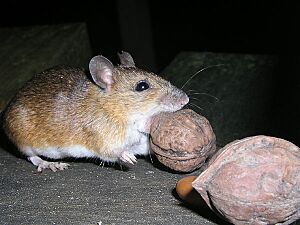Large Japanese field mouse facts for kids
Quick facts for kids Large Japanese field mouse |
|
|---|---|
 |
|
| Conservation status | |
| Scientific classification | |
| Genus: |
Apodemus
|
| Species: |
speciosus
|
The large Japanese field mouse (Apodemus speciosus) is a type of rodent that is active at night. It belongs to the Muridae family, which includes many mice and rats. This mouse is special because it is found only in Japan.
Contents
Where Do Large Japanese Field Mice Live?
These mice live all over the islands of Japan. You can find them in many different places, like forests, grassy areas, and even farm fields, including rice paddies. They can live at any height, from sea level to high up in the mountains.
While they share some living spaces with another mouse, A. argenteus, they have different favorite spots. The large Japanese field mouse likes open forests that have grown back after being cut down. The other mouse prefers places with very thick tree cover.
What Do Large Japanese Field Mice Eat?
Large Japanese field mice are active mostly at night. This helps them avoid animals that might try to eat them. They are omnivores, meaning they eat both plants and animals. However, they are best known for eating seeds, especially in autumn and winter.
They love to collect and store acorns and walnuts. These nuts can make up a huge part of their diet, sometimes even all of it! Because they carry seeds around and sometimes forget where they buried them, these mice help new trees grow. This makes them important for the forest.
How Light Affects Their Foraging
Large Japanese field mice change how they look for food depending on how bright it is. When there's more light, they spend less time outside their nests. They also take shorter trips and eat less food while they are out.
When it's bright, they tend to carry food back to their nests to eat it safely. When it's dark, they usually eat their food right where they find it. These changes help them stay safe from predators. For example, they avoid bright, open areas on the ground when hunting at night.
Dealing with Tricky Foods
Many of the acorns and nuts these mice eat have high levels of something called tannin. Tannins can be harmful to rodents if they eat too much. But large Japanese field mice have special ways to handle this.
- They can get used to nuts with lots of tannin. Their bodies make special proteins and use certain bacteria to help them digest these tough foods.
- They also try to pick acorns that have lower levels of tannin in the first place.
These adaptations help the mice eat the foods they need while staying healthy.
Smart Eaters: How Mice Learn to Forage
Like many rodents, large Japanese field mice can learn new things about finding food. For example, mice that have eaten walnuts before can eat them faster and more easily than mice that haven't.
Even mice that have never seen a hard-shelled walnut can learn how to eat them better in just two weeks! This shows that their foraging skills aren't just in their genes. They can learn by trying things out.
Their environment also plays a role. Mice that grew up around nuts with lots of tannin learn to be pickier about what they eat. Being able to learn and adapt quickly helps these mice survive in different places without having to wait for evolution to change them over many generations.


